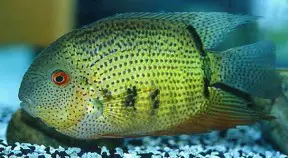Heros notatus
Spotted Severum
Classification
Cichlidae. Subfamily: Cichlasomatinae
Distribution
Endemic to the Rio Negro basin, Brazil.
Habitat
Blackwater rivers and tributaries. The water in these biotopes is typically stained brown with tannins from decaying organic material and is very acidic as a result. This species is often found in marginal areas around submerged tree roots and branches.
Maximum Standard Length
12″ (30cm)
Aquarium SizeTop ↑
48″ x 15″ x 15″ (120cm x 37.5cm x 37.5cm) – 175 litres
Maintenance
Provide a well planted tank with areas of open swimming space. A sand substrate is recommended as this fish likes to dig. Other decor in the form of bogwood, branches and smooth stones can also be used. Lighting levels are not critical and can be matched to the requirements of the plants used.
Water Conditions
Temperature: 22 – 29° (72 – 84°F)
pH: 6.0 – 7.0
Hardness: Up to 10°H
Diet
Omnivorous. Accepts most foods in the aquarium. Feed a good quality cichlid pellet as a staple. Supplement this with foods such as bloodworm and brineshrimp or small pieces of prawn and white fish for larger severums. Will also appreciate some vegetable matter in the diet in the form of algae wafers or blanched greens.
Behaviour and CompatibilityTop ↑
Not a particularly aggressive species, although males may squabble with conspecifics. May be kept as part of a larger cichlid community or with other robust species such as larger characins and barbs. Much smaller fish will almost certainly be eaten.
Sexual Dimorphism
Male is bigger, has more defined reddish markings on the gill covers and tends to develop longer extensions to the dorsal and anal fins.
Reproduction
Limited reports of breeding in the hobby, as the fish is not often seen for sale.
Breeding is likely to follow similar patterns to heros severus where the pair will select a flat stone, or sometimes excavate a pit. Once the breeding area is prepared, eggs will be deposited by the female and then fertilised by the male. Both fish guard the eggs and when the fry hatch two to three days later, they are transferred to a pit where the parents keep them until they become free-swimming. This is usually 3 – 4 days after hatching. Both fish assume parental duties but can be easily spooked often leading to them eating the fry. It is advisable that the breeding tank be placed in a quiet location and distrubed as little as possible.
Fry can be fed on newly-hatched brineshrimp and powdered fry foods until large enough to take bigger foods.
NotesTop ↑
A rarely seen, although attractive member of the severum family. This species is occasionally offered for sale through specialist cichild or South American dealers.



December 7th, 2013 at 10:33 pm
120cm long tank will be a bit too small for such a big and messy fish IMO. Tank length at least 150 cm would be more suitable for one Heros.
October 4th, 2018 at 3:39 pm
“Limited reports of breeding in the hobby, as the fish is not often seen for sale.”-My pair of Heros Notaus are breeding alle the time. You have to remove the fry from their parrents otherwise they will eat them. I tend to do nothing so there for i have no one for sale. In fact they can be hard to sell, so why bother with it?